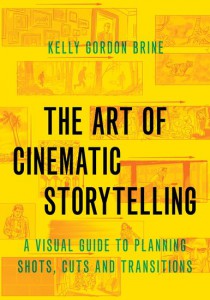The Art of Cinematic Storytelling
A Visual Guide to Planning Shots, Cuts, and Transitions


Moyenne des votes : ![]()
| 0 | vote | |
| 0 | vote | |
| 0 | vote | |
| 0 | vote |
Votre vote : -
Description de l'ouvrage:
• Offers a concise and accessible introduction to the practice of visual storytelling in a single volume
• Provides insight into the storytelling approaches of working directors and cinematographers
• Grounded in real-world film production by the author's decades of experience in the film industry
• Includes more than 250 illustrations from the work of a professional storyboard artist
To dramatize a story using moving images, a director must have a full understanding of the meaning and emotional effect of all the various types of shots and cuts that are available to advance the story. Drawing upon his extensive experience as a storyboard artist who has worked with over 200 directors and cinematographers on television series and movies, author Kelly Gordon Brine provides a practical and accessible introduction to the design of shots, cuts, and transitions for film, television, animation, video, and game design.
With hundreds of illustrations and diagrams, concise explanations of essential storytelling concepts, and vivid examples, The Art of Cinematic Storytelling demystifies the visual design choices that are fundamental to directing and editing. The author delves deeply into the techniques that visual storytellers use to captivate their audience, including blocking, camera positioning, transitions, and planning shots with continuity editing in mind. Practical advice on how to clarify time, space, and motion in many common situations — such as dialogue, pursuits, and driving sequences — makes this book an invaluable guide for all aspiring filmmakers.
À propos de l'auteur :
Kelly Gordon Brine, Freelance Storyboard Artist Kelly Gordon Brine is a storyboard artist. He has worked on dozens of television shows, including The Witcher, Umbrella Academy, Lost in Space, Jessica Jones, and Person of Interest, and has taught drawing as an assistant professor at the University of Toronto. He holds a Bachelor of Mathematics degree.
Revue de Presse:
"I've benefited from the author's storyboarding expertise to help me previsualize the shots and cuts on dozens of complex projects. His book shows how directing, cinematography, and editing work together to present the narrative visually. His insights about visual storytelling are like a creative force multiplier and will help aspiring filmmakers achieve their very best." - Stephen D Surjik, television and film director whose many credits include The Witcher, Umbrella Academy, Lost in Space, See, Jessica Jones, and Luke Cage.
"Mind-blowing visual effects, dangerous stunts, and exhilarating action used to be the sole domain of big-budget film. But with 'peak TV' came the same expectations for the small screen. With less time and less money, the only way for directors and producers to deliver is to storyboard like a pro. The author's easy-to-follow techniques on how to break the most complex scenes into essential shots has been my secret weapon for cinematic television." - Chris Fisher, Producer/Director of Warehouse 13, Person of Interest, The Magicians, and Strange New Worlds.
Voir le site internet de l'éditeur Oxford University Press
> Sur un thème proche :
A Guide to Post-classical Narration (2023)
The Future of Film Storytelling
Sujet : Technique > Scriptwriting
Introduction to Screen Narrative (2023)
Dir. Paul Taberham et Catalina Iricinschi
Sujet : Technique > Scriptwriting
Impossible Puzzle Films (2016)
A Cognitive Approach to Contemporary Complex Cinema
de Miklós Kiss et Steven Willemsen
Sujet : Technique > Scriptwriting
Storytelling in the New Hollywood (1999)
Understanding Classical Narrative Technique
Sujet : Technique > Scriptwriting
Beyond the Monoplot (2025)
How to Write Unconventional Films (and Why We Should)
de Chris Neilan
Sujet : Technique > Scriptwriting
Scriptnotes (2025)
A Book About Screenwriting and Things That Are Interesting to Screenwriters
de John August et Craig Mazin
Sujet : Technique > Scriptwriting